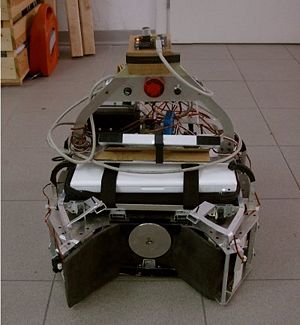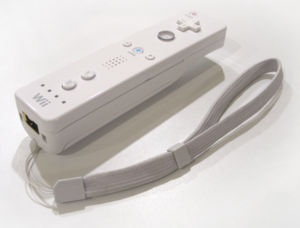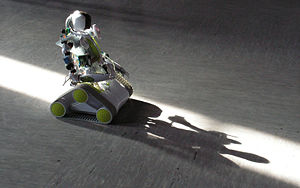Difference between revisions of "ROBOWII"
(→People Involved) |
m |
||
| (137 intermediate revisions by 5 users not shown) | |||
| Line 1: | Line 1: | ||
| − | == | + | <!--{{Project |
| + | |title=ROBOWII | ||
| + | |image=SkypeWII1Small.JPG | ||
| + | |short_descr=Meta-Project on the implementation of robotic games using the WIIMote interface | ||
| + | |coordinator=AndreaBonarini | ||
| + | |resarea=Robotics | ||
| + | |restopic=Robogames | ||
| + | |start=2008/10/01 | ||
| + | |end=2011/12/31 | ||
| + | |status=Closed | ||
| + | }}--> | ||
| + | === General description === | ||
| − | |||
<br> | <br> | ||
| − | + | Aim of projects in this area is to develop games where people interact with autonomous robots by using the WII Remote, the main controller of the Nintendo WII console. The area is coordinated by [[User:AndreaBonarini|Andrea Bonarini]], and belongs to the [[Robogames]] activities. | |
| + | |||
| + | Since WII Remote (shortly: [[WIIMote]]) has onboard a 3-axis accelerometer, and infrared camera, a speaker, 4 leds, a vibration system and many buttons, it could be used as a human-computer interface in many robotic applications. [http://www.ted.com/talks/view/id/245 This link] is about some of the things that can be done with a WIIMote. Check Johnny Lee on Youtube for more... | ||
| + | |||
| + | In parallel, some projects are facing problems of designing [[RobogameDesign|interactive games involving autonomous robots]] and [[Highly Interactive Robogames]]. | ||
<br/> | <br/> | ||
| + | ----- | ||
| + | === Active Projects=== | ||
| + | ----- | ||
| + | |||
| + | === Finished Projects === | ||
| + | ==== RoboWII 1.0 ==== | ||
| + | |||
| + | [[Image:Robowii_robot.jpg|thumb|right|300px|The first robot]] | ||
<br> | <br> | ||
| − | + | Antonio Bianchi and Ben Chen developed a game system ([[RoboWII1.0|RoboWII1.0]]) where the human player has to try to point a led target on the robot with the infrared camera of the WIIMote, while the robot tries to get a target position and at the same time to avoid to be caught. | |
| − | + | ||
<br/> | <br/> | ||
| − | [[Image: | + | [[Image:Wiimote.jpg|thumb|left|Wii Remote controller]] |
<br> | <br> | ||
| − | + | They have used a robot originally used in Robocup, with a two-wheels differential kinematics. | |
| − | + | RoboWII has been developed in Linux, using C++. The communication between computer and WIIMote is done using the library Wiiuse. Moreover, some packages developed at Politecnico di Milano within the MRT project (Modular Robotic Toolkit) have been used: | |
| − | + | *DCDT, for message exchange among the components of RoboWII | |
| − | *DCDT, | + | *Mr. Brian, to program fuzzy logic behaviors |
| − | *Mr. Brian, | + | |
| − | + | ||
<br/> | <br/> | ||
| + | <br>The localization software was originally developed within the [[LURCH_-_The_autonomous_wheelchair|LURCH project]], and is able to localize the robot w.r.t. a set of printed markers placed on the ceiling over the playground. This software uses the ArtToolkitPlus libraries. | ||
| + | <br/> | ||
| + | |||
| + | ==== WhereWiiAre ==== | ||
| + | [[User:MatteoBotta|Matteo Botta]] and [[User:AlbertoBottinelli|Alberto Bottinelli]] developed for their bachelor thesis a marker-based self-localization system using the WIIMote: [[WhereWIIAre|WhereWIIAre]] | ||
| + | |||
| + | ==== RoboWII 2.0 ==== | ||
| + | [[User:AntonioMicali|Antonio Micali]] has developed a second, improved version of the ROBOWII game ([[RoboWII2.0|RoboWII2.0]]) on the robot [[Spykee]] | ||
| + | |||
| + | [[Image:SkypeWII1Small.JPG |thumb|right|300px|Spykee, one of the current RoboWII bases]] | ||
| + | |||
| + | ==== RoboWII 2.0.L ==== | ||
| + | [[User:GabrielePallotta|Gabriele Pallotta]] and [[User:LuigiParpinel|Luigi Parpinel]] Have developed a new [[Lego Mindstorms NXT]]-based robot and a new game for it: [[RoboWII2.0.L|RoboWII2.0.L]]. | ||
| + | |||
| + | ==== RoboWII 2.0.1 ==== | ||
| + | [[User:AndreaPontecorvo|Andrea Pontecorvo]] has developed a new ROBOWII game ([[RoboWII2.0.1|RoboWII2.0.1]]) on the robot [[Spykee]] | ||
| + | |||
| + | ==== Hide and Seek 2 ==== | ||
| + | [[User:DavideGadioli|Davide Gadioli]] has developed a kind of [[Hide_and_Seek_2|Hide and Seek]] Robogame with the former help of [[User:MattiaBerlusconi|Mattia Berlusconi]]. | ||
| + | |||
| + | ==== RoboWII 2.1 ==== | ||
| + | [[User:AlessandroMarin|Alessandro Marin]] and [[User:DiegoMereghetti|Diego Mereghetti]] have developed RoboWII 2.1 a new version of a game system for Human-Computer Interaction Laboratory: [[RoboWII2.1|RoboWII 2.1]], further developed by [[User:DeborahZamponi|Deborah Zamponi]] and[[User:CristianMandelli| Cristian Mandelli]]. This project is part of the ROBOWII effort, in turn on the [[Robogames]] research line. | ||
| + | |||
| + | ==== RunBot ==== | ||
| + | [[User:AnilKoyuncu|Anil Koyuncu]] has developed a new robot for more active playing: [[RunBot: a Robogame Robot |RunBot]] | ||
| + | |||
| + | ----- | ||
| + | |||
| + | === Robowii Video === | ||
| + | |||
| + | {{#ev:youtube|NWPOIApoUvc}} | ||
| + | |||
| + | *[http://www.youtube.com/watch?v=NWPOIApoUvc External link] | ||
| + | RoboWII2.0. First test of the game at Open Day on April 4th, 2009 with an expert user. | ||
| + | |||
| + | {{#ev:youtube|4brVUut4PeE}} | ||
| + | |||
| + | *[http://www.youtube.com/watch?v=4brVUut4PeE External link] | ||
| + | RoboWII2.0. First test of the game at Open Day on April 4th, 2009 with a novice user. Some improvements are needed to reduce fear and increase understandability of the game. Comments coming from video analysis on the discussion page. | ||
| + | |||
| + | |||
| + | {{#ev:youtube|P7bFBA0thao}} | ||
| − | = | + | *[http://www.youtube.com/watch?v=P7bFBA0thao External link] |
| + | RoboWII 2.0. The robot and the new led interface to improve the playability of the game. | ||
| + | The green led indicates when the robot is pointed by the WIIMote. The red leds indicate the time of charge, when they are all lit it's possible to hit the robot. | ||
| − | + | {{#ev:youtube|1cjWLKWOUkw}} | |
| − | [http://www. | + | *[http://www.youtube.com/watch?v=1cjWLKWOUkw External link] |
| + | [[Robo-Hide-and-Hunt]] a robogame designed in the [[RobogameDesign|Robogame design effort]] | ||
| − | + | {{#ev:youtube|TG96ubwVJd8}} | |
| − | + | *[http://www.youtube.com/watch?v=TG96ubwVJd8 External link] | |
| + | [[RoboWII2.0.1]] | ||
| − | + | {{#ev:youtube|pCFMwl73MCE}} | |
| − | = | + | *[http://www.youtube.com/watch?v=pCFMwl73MCE External link] |
| + | [[RoboWII2.1]] | ||
| − | + | ----- | |
| − | + | ===Work done=== | |
| − | + | *Project start: March 2008 | |
| + | *First prototype delivered (Bachelor thesis Bianchi&Chen - September 2008) | ||
| + | *New robot arrival ([http://www.spykeeworld.com/ Spyke]) (Antonio Micali - November 2008) | ||
| + | *New interface to control the new robot from a remote PC (Antonio Micali - December 2008) | ||
| + | *Sonar belt on Skype e first game on it (Antonio Micali - December 2008) | ||
| + | *Conceptual design of a hiding game (Andrea Pontecorvo - April 2009) | ||
| + | *Conceptual design of the Jedi Training game (Adrien Servier, Andrea Nicotra - April 2009) | ||
| + | *Installation of sonar belt on Skype (Antonio Micali - March 2009) | ||
| + | *Developed a new leds interface to improve the playability of the game (Antonio Micali - April 2009) | ||
| + | *Extension of the existing game considering the sonar belt (Antonio Micali - April 2009) | ||
| + | *Test if the first Spyke game (Antonio Micali - April 2009) | ||
| + | *Tuning of the first Spyke game (Antonio Micali - May 2009) | ||
| + | *Design and implement a new RoboWII Game obased on fixed robot (Adrien Servier, Andrea Nicotra - 2009) | ||
| + | *Design and implementation of a new game with game design methodology (Andrea Pontecorvo - 2009) | ||
| + | *Design Lego robot and implementation (Gabriele Pallotta, Luigi Parpinel - 2009) | ||
| + | *Design a new robot (Anil Koyuncu) - July 2010 | ||
| + | * Robo-Hide-and-Seek finished - July 2010 | ||
| + | *Robowii2.1 finished - September 2010 | ||
| + | * Runbot finished - April 2011 | ||
| − | |||
| − | |||
| − | |||
| + | ----- | ||
=== Laboratory work and risk analysis === | === Laboratory work and risk analysis === | ||
Latest revision as of 18:43, 21 March 2012
Contents
General description
Aim of projects in this area is to develop games where people interact with autonomous robots by using the WII Remote, the main controller of the Nintendo WII console. The area is coordinated by Andrea Bonarini, and belongs to the Robogames activities.
Since WII Remote (shortly: WIIMote) has onboard a 3-axis accelerometer, and infrared camera, a speaker, 4 leds, a vibration system and many buttons, it could be used as a human-computer interface in many robotic applications. This link is about some of the things that can be done with a WIIMote. Check Johnny Lee on Youtube for more...
In parallel, some projects are facing problems of designing interactive games involving autonomous robots and Highly Interactive Robogames.
Active Projects
Finished Projects
RoboWII 1.0
Antonio Bianchi and Ben Chen developed a game system (RoboWII1.0) where the human player has to try to point a led target on the robot with the infrared camera of the WIIMote, while the robot tries to get a target position and at the same time to avoid to be caught.
They have used a robot originally used in Robocup, with a two-wheels differential kinematics.
RoboWII has been developed in Linux, using C++. The communication between computer and WIIMote is done using the library Wiiuse. Moreover, some packages developed at Politecnico di Milano within the MRT project (Modular Robotic Toolkit) have been used:
- DCDT, for message exchange among the components of RoboWII
- Mr. Brian, to program fuzzy logic behaviors
The localization software was originally developed within the LURCH project, and is able to localize the robot w.r.t. a set of printed markers placed on the ceiling over the playground. This software uses the ArtToolkitPlus libraries.
WhereWiiAre
Matteo Botta and Alberto Bottinelli developed for their bachelor thesis a marker-based self-localization system using the WIIMote: WhereWIIAre
RoboWII 2.0
Antonio Micali has developed a second, improved version of the ROBOWII game (RoboWII2.0) on the robot Spykee
RoboWII 2.0.L
Gabriele Pallotta and Luigi Parpinel Have developed a new Lego Mindstorms NXT-based robot and a new game for it: RoboWII2.0.L.
RoboWII 2.0.1
Andrea Pontecorvo has developed a new ROBOWII game (RoboWII2.0.1) on the robot Spykee
Hide and Seek 2
Davide Gadioli has developed a kind of Hide and Seek Robogame with the former help of Mattia Berlusconi.
RoboWII 2.1
Alessandro Marin and Diego Mereghetti have developed RoboWII 2.1 a new version of a game system for Human-Computer Interaction Laboratory: RoboWII 2.1, further developed by Deborah Zamponi and Cristian Mandelli. This project is part of the ROBOWII effort, in turn on the Robogames research line.
RunBot
Anil Koyuncu has developed a new robot for more active playing: RunBot
Robowii Video
RoboWII2.0. First test of the game at Open Day on April 4th, 2009 with an expert user.
RoboWII2.0. First test of the game at Open Day on April 4th, 2009 with a novice user. Some improvements are needed to reduce fear and increase understandability of the game. Comments coming from video analysis on the discussion page.
RoboWII 2.0. The robot and the new led interface to improve the playability of the game. The green led indicates when the robot is pointed by the WIIMote. The red leds indicate the time of charge, when they are all lit it's possible to hit the robot.
Robo-Hide-and-Hunt a robogame designed in the Robogame design effort
Work done
- Project start: March 2008
- First prototype delivered (Bachelor thesis Bianchi&Chen - September 2008)
- New robot arrival (Spyke) (Antonio Micali - November 2008)
- New interface to control the new robot from a remote PC (Antonio Micali - December 2008)
- Sonar belt on Skype e first game on it (Antonio Micali - December 2008)
- Conceptual design of a hiding game (Andrea Pontecorvo - April 2009)
- Conceptual design of the Jedi Training game (Adrien Servier, Andrea Nicotra - April 2009)
- Installation of sonar belt on Skype (Antonio Micali - March 2009)
- Developed a new leds interface to improve the playability of the game (Antonio Micali - April 2009)
- Extension of the existing game considering the sonar belt (Antonio Micali - April 2009)
- Test if the first Spyke game (Antonio Micali - April 2009)
- Tuning of the first Spyke game (Antonio Micali - May 2009)
- Design and implement a new RoboWII Game obased on fixed robot (Adrien Servier, Andrea Nicotra - 2009)
- Design and implementation of a new game with game design methodology (Andrea Pontecorvo - 2009)
- Design Lego robot and implementation (Gabriele Pallotta, Luigi Parpinel - 2009)
- Design a new robot (Anil Koyuncu) - July 2010
- Robo-Hide-and-Seek finished - July 2010
- Robowii2.1 finished - September 2010
- Runbot finished - April 2011
Laboratory work and risk analysis
Laboratory work for this project is mainly performed at AIRLab/Lambrate. It includes some mechanical work and electrical and electronic activity. Potentially risky activities are the following:
- Use of mechanical tools. Standard safety measures described in Safety norms will be followed.
- Use of soldering iron. Standard safety measures described in Safety norms will be followed.
- Transportation of heavy loads (e.g. robots). Standard safety measures described in Safety norms will be followed.
- Robot testing. Standard safety measures described in Safety norms will be followed.


